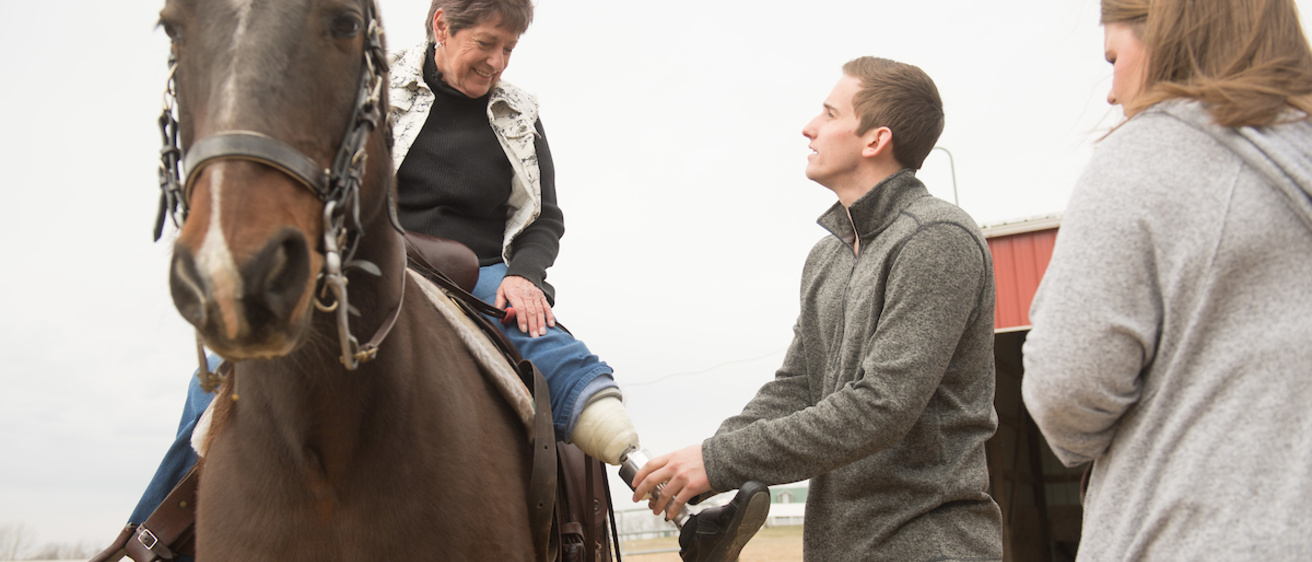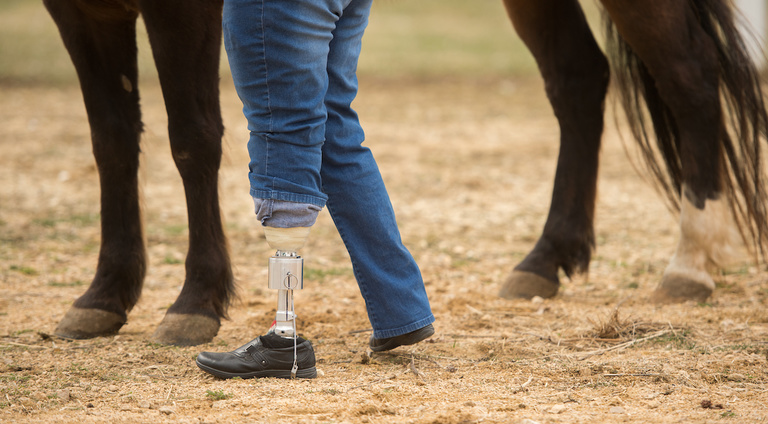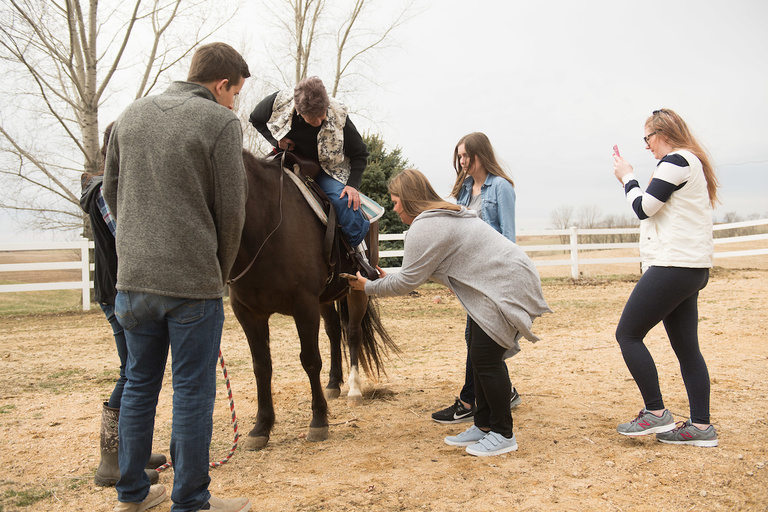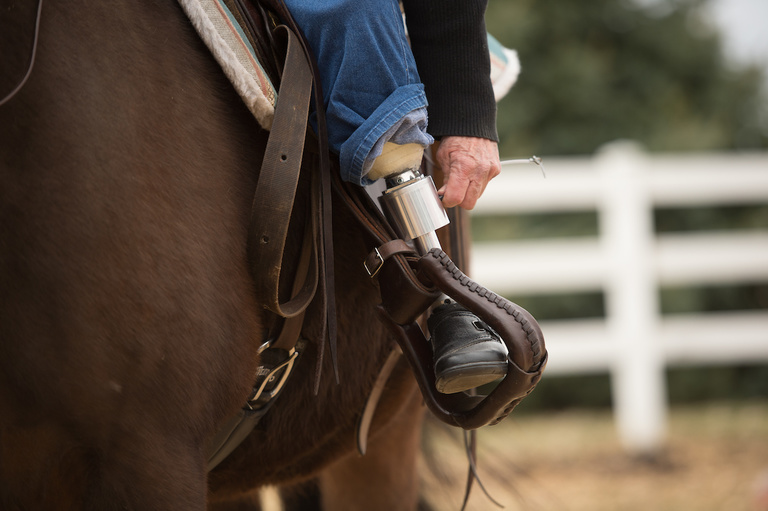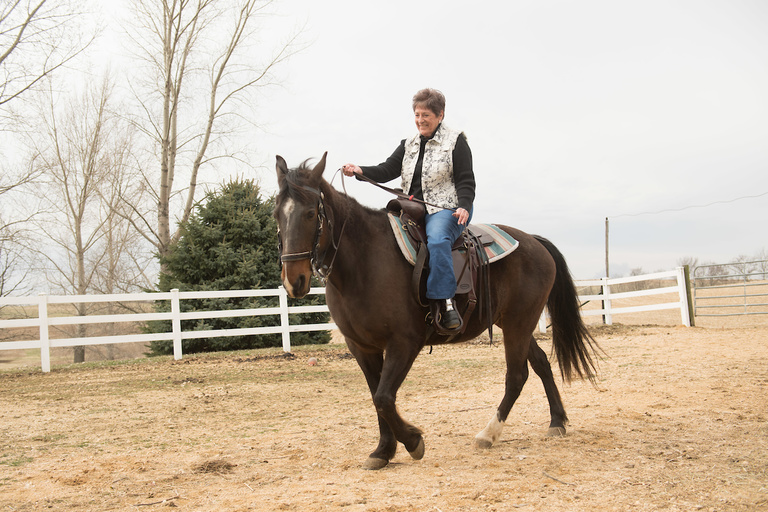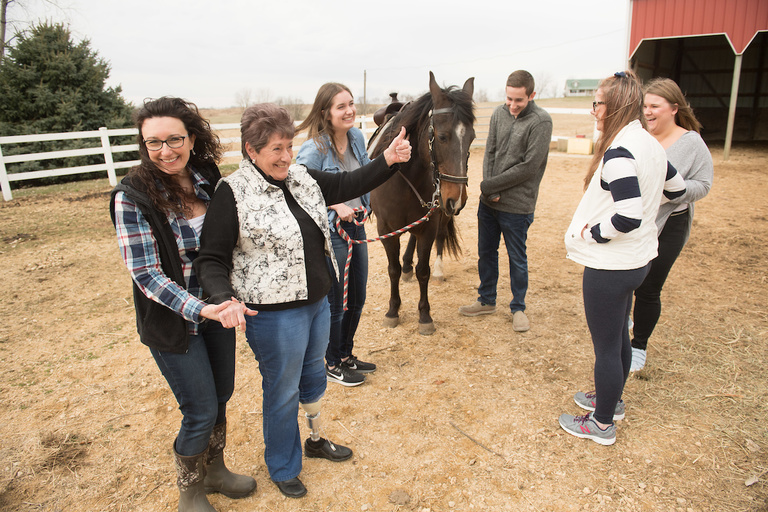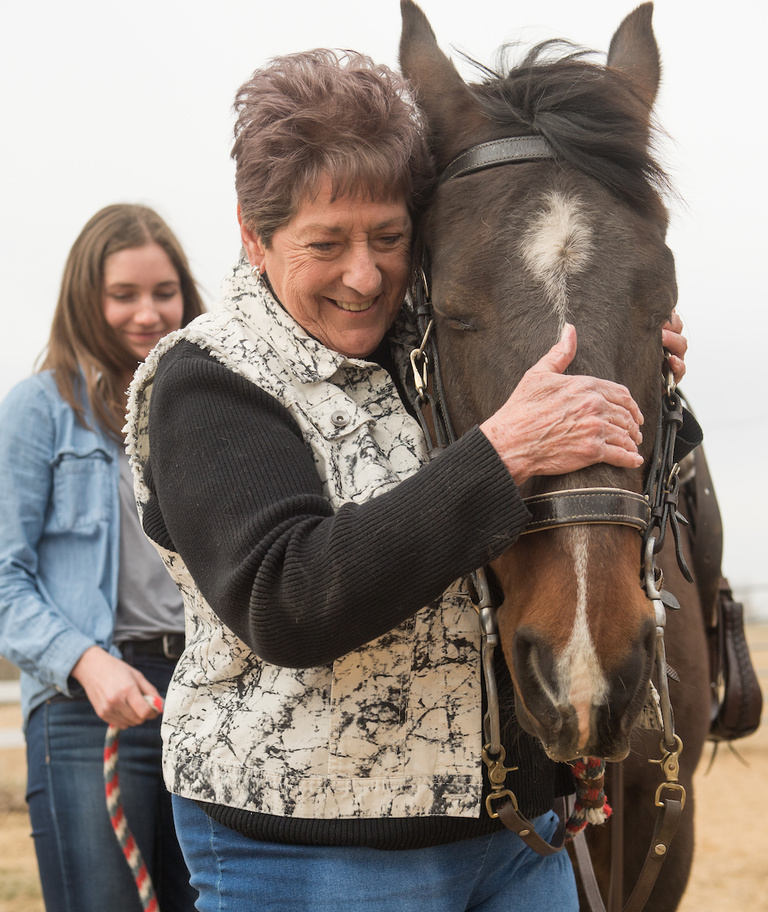Monna Metcalf has never been the type of woman to complain. During her more than seven decades of life, she’s held a number of challenging jobs, raised two daughters, and lost the lower half of her left leg in a farm accident.
Even the surgeries and physical therapy sessions she endured as a result of the 1994 accident couldn’t bring her down. As part of her recovery process, Metcalf took up horseback riding. She bought a horse named Yankee, the first of several she would own, and started riding near her home in Zwingle, Iowa. She loved riding Yankee, and later Yankee’s son, Rebel, at full gallop across a river or stream—water splashing, her heart swelling with joy.
But as time passed, riding became uncomfortable for Metcalf, 75. Her prosthetic leg, which attaches just below her knee, rubbed against her skin, causing painful sores. The rigid prosthetic leg never was particularly comfortable when she rode, but now, as her skin aged and muscle mass diminished, she had more difficulty feeling comfortable in the saddle.
Her daughter, Aulanda Krause, also of Zwingle, watched her once energetic mother slump into depression. What could she do? Who could help her get her mom back on her beloved horse?
Her answer came one night last year while watching the evening news. The local TV station broadcast a story about a group of University of Iowa biomedical engineering students who created a prosthetic device to help a boy born without an arm ride his bike.
That’s it, thought Krause.
Krause got on her computer, found the UI College of Engineering website, filled out an online form, hit submit, and waited. Not long after, she was notified that a group of biomedical engineering students—Madison Chrisman, Elizabeth Niedert, Glen Schoenbeck, and Paighton Schrupp—selected her project as their senior design challenge, a year-long course that tests students’ engineering knowledge and ability to problem-solve.
“I have noticed my mom lose her zest for life and it breaks my heart,” Krause wrote in her application. “She spends her days watching the clock until it is time to go back to bed, and she is becoming depressed. She has always persevered and now I watch her sit and stare at the walls until the day is done...I need my mom back.”
Eager to get started on the project, the engineering students contacted Krause in September 2017 and learned that Metcalf was at the UI Hospitals and Clinics, recuperating from a surgery. The students first met Metcalf in her hospital room, and after about an hour of discussion, they agreed they needed to create two devices—one that would make it possible for her to ride her horse with her prosthetic leg without pain, and a second that would allow her to easily mount and dismount. Because of her prosthetic leg, Metcalf often used a handmade wooden staircase to get on and off her horse, but she needed something portable.
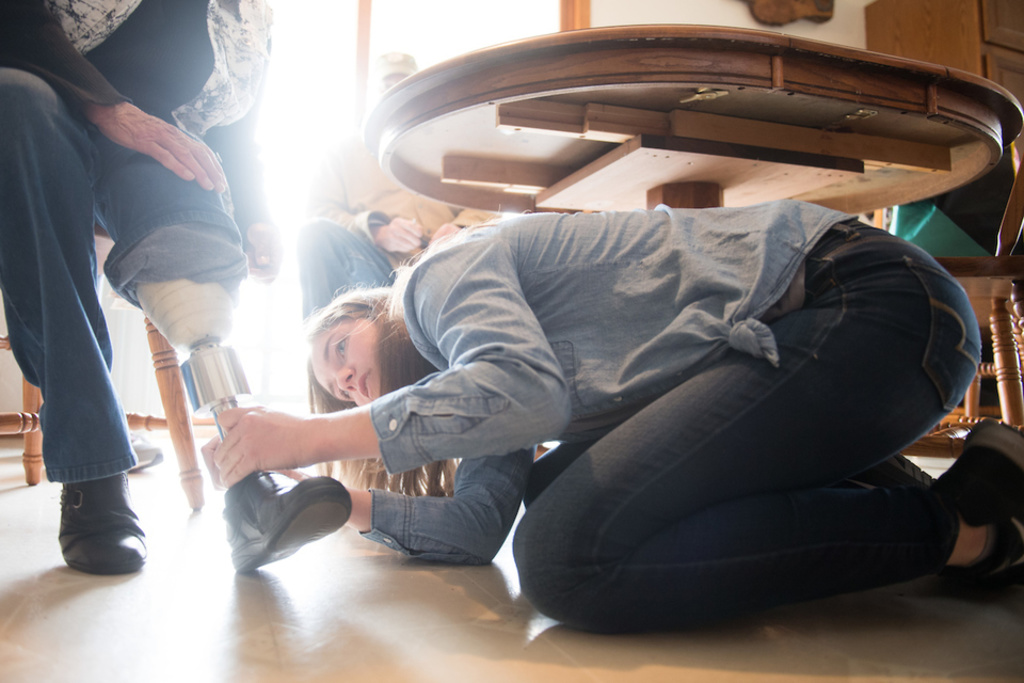
“In the beginning, I wasn’t sure if it would even be possible to get my mom back up on her horse,” said Krause, a special education teacher in Dubuque, Iowa. “I wondered if the pain she was experiencing was just her new normal. But I knew we had to try to find a solution. Maybe we would fail, but we had to try.”
The students went to work and soon they came up with an idea for a rotation mechanism that would attach to Metcalf’s prosthetic leg and work as a sort of mechanical ankle, allowing her to manually swivel her prosthetic foot into her saddle stirrups. With the rotation device in place, the students hypothesized that the prosthetic leg would cause less discomfort. The students also designed a lightweight, portable ladder that Metcalf could use to get on her horse and then collapse with the tug of a cord.
“Pretty quickly, we realized that any solution would have to be easily integrated into Monna’s life,” says Niedert, a senior biomedical engineering student from Glen Ellyn, Illinois. “We really wanted her to regain her independence and the freedom she felt when she was riding Rebel.”
Students spent much of the fall and winter perfecting designs for both the rotation device and the portable ladder. They consulted with experts in the College of Engineering’s machine shop, where several iterations of the rotation device were created. They also worked with Metcalf’s prosthetist-orthotist in Dubuque, Pat McTaggart, who had helped Metcalf during the years since her accident and was familiar with her unique needs. Along with Krause and Metcalf, he provided encouragement to the students as they struggled to come up with solutions.
The students visited Metcalf at her home, which is decorated with images of cowboys and horses, several times over the course of the project. They met her current horse, Rebel, a chocolate brown Missouri Fox Trotter with a white blaze on his forehead, and played with her cat, Sassy Boo. From the start, Metcalf was adamant about getting back in the saddle. She told them that pain and discomfort caused by her prosthetic leg had made it impossible for her to ride Rebel for several months before her surgery. And while she was feeling better post-surgery, she still could not ride for long periods of time for fear of developing new sores.
“Oh boy, I have had days of depression,” Metcalf told the students. “Not being able to do the things you used to do, it gets to you. I just want to get back out there. Rebel’s waiting for me.”
As winter turned to spring and the due date for the senior design project grew near, the students made one last trip to Zwingle. They brought with them the final iteration of the rotation device they created for Metcalf (there were three in all), as well as a collapsible ladder for her to use to mount and dismount her horse. Their plan was to present the devices to Metcalf, let her test the rotation device in her kitchen, and then, if she was confident, take her outside to test both the rotation device and the collapsible ladder in the paddock with Rebel.
On the morning of the big day, everyone gathered in Metcalf’s kitchen. The weather outside was cold and gloomy, but the atmosphere in the kitchen was warm and supportive. Seated at her kitchen table, Metcalf, with the help of the students and MacTaggart, attached the rotation device to the end of her prosthetic leg and tried to pull out the small metal pin that unlocks it and allows it to swivel.
“I think we need some WD-40,” she joked, when she had trouble removing the pin.
Once the pin was out, Metcalf watched the device rotate, saw how the prosthetic foot swiveled, and put the pin back in, which locked it in place. Satisfied that the device wouldn’t rotate, she stood up and took a few steps around the kitchen; then headed for the door.
“Rebel’s waiting for me,” she called back, not waiting for the others to follow.
Outside in Rebel’s paddock, Metcalf greeted the horse with soft pats to his nose and forehead. Rebel was already saddled and was clearly curious about the gaggle of people standing about, some taking photos with cellphones.
Once in the saddle, Metcalf removed the pin from the rotation device, just as she’d practiced in the kitchen, and rotated the prosthetic foot into the stirrup. She tucked the pin into a pocket, grabbed the reins, and gently nudged Rebel forward. They moved slowly around the paddock while everyone else watched and waited. After a loop or two around the enclosure, Metcalf smiled and gave the thumbs up sign.
“Is your leg twisting?” asked Krause, voicing the question on everyone’s mind.
“No, there’s no twisting,” her mother replied. Then, she patted Rebel’s back and said, “Can you say thank you?”
With the test of the rotation device done, students carried the portable ladder into the paddock and set it up. In the end, the cost to build a collapsible ladder from scratch was too much, and so they purchased a light-weight kitchen ladder that Metcalf can transport in her truck when she travels with Rebel.
With the ladder ready, Metcalf put the pin back in the rotation device, dismounted Rebel, and slowly backed herself down the rungs. Her feet back on the ground, she once again flashed the thumbs up sign and gave Rebel some more pats.
For Chrisman, Niedert, Schoenbeck, and Schrupp, the moment was pure gold. They flashed smiles at each other and gathered around Metcalf, Krause, and Rebel. Schoenbeck, who established a bond with Rebel (no one could say how or why, since the student had no experience with horses), even got a chance to ride the horse around the paddock.
“Go, Glen!” Schoenbeck’s teammates shouted. “Looking good!”
However, the star of the day very clearly was Metcalf.
“It’s just incredible to see her riding again, to see her smiling,” said Paighton Schrupp, a senior biomedical engineering student from Willmar, Minnesota. “When we started this project, we had no idea how it would turn out—for us or for Monna. When we met her, she was in the hospital and she was at her worst.”
After photos and hugs in the paddock and a handful of fresh hay for Rebel, everyone went inside the house for cookies and cupcakes. Metcalf, still walking on her prosthetic leg with the student-made rotation device attached, moved about her kitchen with ease. She laughed with the students and listened with interest and a hint of pride as they talked about their post-graduation plans.
“It’s so heartwarming to work with someone like Monna and to see her regain something she thought she’d lost,” said Madison Chrisman, a senior biomedical engineering student from Knoxville, Iowa. “I want to experience this feeling every day.”
And as the four students prepare for new, post-graduation adventures, Metcalf is eager to get back outside with Rebel. She already has plans to travel to Missouri in the fall for an annual trail ride with friends. Her truck and horse trailer are parked in the driveway and ready for loading, and now that she has her rotation device and ladder, Metcalf feels ready.
“To go out into the woods again and see things you wouldn’t normally see, that’s what I’m looking forward to,” she said. “Rebel has been my life saver. He will take me wherever I want to go.”
